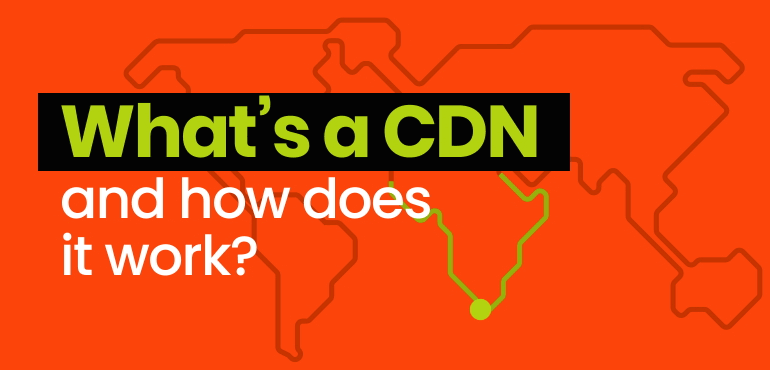What’s a CDN, and how does it work?

Article topics
- What is a content delivery network?
- How does a CDN work?
- What are the benefits of a content delivery network?
- Is a CDN right for my business?
- Are CDNs expensive?
- How do I implement a CDN?
When you are responsible for running an eCommerce website, there are lots of abbreviations that you need to make yourself aware of. It’s like learning an entirely new language!
One of the abbreviations you may come across is CDN, or content delivery network. While not every online business needs to take advantage of one, a CDN service may provide many benefits to your eCommerce store, especially if you have customers in multiple countries.
Scratching your head over what a CDN is? Don’t worry; it’s not as complicated as it sounds! Let’s look at content delivery networks, how they work, and where you may need to use one.
What is a content delivery network?
A CDN is a network of servers distributed all across the world, which bring data closer to website users. These servers are called Points of Presence, or PoPs.
A content delivery network may also be referred to as a content distribution network.
CDNs have been in place since the 1990s; however, they have become more sophisticated and less expensive over time.
It’s estimated that nearly 27% of all websites use a CDN.
How does a CDN work?
Let’s say you’re in the UK and you’re trying to access a website in the US.
The server that contains this information would need to deliver the data from the US to the UK – a distance of 4,255 miles! This might mean the website takes a longer time to load than usual, by which point, you’ve got bored and left.
If a CDN is in place, all the assets on your web pages, like videos, images, and CSS style sheets, can be stored in a PoP, several of which are in the UK.
You might hear the word ‘latency’ used when referring to CDNs. This is the amount of time it takes for a data packet to go from one place to another. The lower the latency, the better!
When someone accesses your website, all the cached assets are retrieved from the PoP instead of the original server (referred to as the ‘origin server’ in CDN terminology).
This means the content loads more quickly, and you don’t have to wait as long to see it.

What are the benefits of a content delivery network?
So we now know what a CDN is, but how can using one put your business at an advantage?
You can deliver content faster
People are getting increasingly impatient, with nearly half of internet users expecting pages to load in less than two seconds! When people get frustrated with page load speed, they may leave your site.
This not only means fewer sales, but can lead to a high bounce rate, which can have a negative impact on your search engine optimisation efforts.
Utilising a CDN means your eCommerce store loads up to 50% more quickly, keeping your customers happy and meaning more revenue for your business.
You can provide a more reliable service
We all panic when our favourite website goes down temporarily! Power cuts, coding errors, and malicious distributed denial of service attacks can all cause servers to stop running.
The good news is that by spreading the load of traffic, CDNs mean your site can still keep running. If one PoP stops working, there are several other servers on standby!
Your site is safeguarded against attack
In the previous section, we mentioned distributed denial of service, or DDos, attacks. Cybercriminals use these attacks to direct large amounts of traffic at a website in an attempt to crash it. It’s estimated that 16 of these attacks take place every minute worldwide.
PoPs work like sponges and can soak up large amounts of web traffic, minimising the impact on your website and keeping your business safe.
You can scale when you need to
The great thing about CDNs is that they grow with your business. If you see a steady increase in traffic or plan to move to new international markets, it’s easy to bring in new PoPs.
CDNs are also great if you see a temporary increase in traffic, for example, from a Black Friday Sale or publicity in the press. Most CDNs operate a usage-based pricing model meaning you just pay for what you use.
Is a CDN right for my business?
Content delivery networks are ideal for companies that distribute content to people across the world.
So if you’re an eCommerce brand with an international presence, you’ll benefit from using a CDN.
However, if you’re a local business that operates in a small area, you may find that a CDN doesn’t bring much benefit to your business.
Are CDNs expensive?
It depends. You can find free CDN services, and there are also CDN networks that cost hundreds or thousands of pounds a month.
As a rule of thumb, the more complex your website and the more traffic you get, the more you pay.
It’s important to remember that a good CDN can help you save money. This is because the CDN handles the bulk of the user requests, meaning the origin server uses less bandwidth to send over information.
How do I implement a CDN?
Many eCommerce platforms have plugins and extensions that apply CDNs to your website. CDNs don’t generally come as standard on eCommerce platforms, which means you have to add them yourself.
For example, if you use WooCommerce, you can install the Cloudflare plugin. We love Cloudflare at Xigen, as it has an extensive global network of PoPs, and automatically optimises the delivery of your web pages for the best possible performance.
Not sure how to set up and configure your CDN? Get in touch, and we’d be happy to help.
We have lots of experience in helping our clients get started with content delivery networks, for example, when we helped Magicshop replatform to Magento.


 Back
Back
